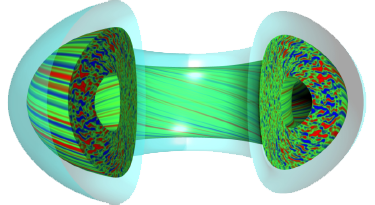Speaker
Description
The development of Synthetic Diagnostics for ITER is essential to optimise the design of the diagnostics, to develop the necessary control algorithms utilising them, and to perform specific physics studies, including integrated data analysis, for each phase of the ITER Research Plan. The work will involve the standardised approach of the Integrated and Modelling & Analysis Suite (IMAS) with the Plasma Control System Simulation Platform (PCSSP) focused on controlling the plasma behaviour and optimising its performance: the signals sent by the diagnostics provide the necessary information to the PCSSP for adjusting the instructions sent to the actuators (heating and current drive, fuelling, etc.) to keep the plasma stable according to the scenario as defined in the pulse schedule.
Developing synthetic diagnostics using the standard IMAS Data Model ensures portability and a more flexible use within different workflows, as well as supporting better traceability and reproducibility of the data generated, providing a robust modelling procedure. Requirements on the performance of each model depends on its application. For example, for dedicated physics studies, physics fidelity and accuracy is favoured, while for the use of models in faster-than-real-time transport suites, computation speed is an essential factor. Various synthetic diagnostic models are available fulfilling the criteria for specific applications, but all have a common requirement: in order to be exploitable within the IMAS/PCSSP platform, they have to follow the IMAS standard, i.e. they have to exchange Interface Data Structures (IDSs) exclusively as input and output. This way, they can take their input from the Scenario and Machine Description databases and provide their output into an IDS specific to the type of the diagnostic, facilitating the comparison and coupling between models.
Using the IMAS standard has permitted the development of a workflow that can generate synthetic diagnostic data from ITER scenario simulations and which encompasses all the various synthetic diagnostic models currently available, providing generality and modularity. A specific example with models for visible spectroscopy is described, in which a single code called CASPER (for CAmera and SPectrocopy Emission Ray-tracer) provides light spectra for all synthetic diagnostic models downstream (Charge Exchange Recombination Spectroscopy, Visible Spectroscopy Reference System, H-alpha, Divertor Impurity Monitor etc.)
Several other Synthetic Diagnostics are already available in IMAS. Examples will be shown of IMAS models developed for Interferometry, Refractometry, Bolometry, Neutron flux monitors, and Visible Spectroscopy. The workflow for Synthetic Diagnostics, still under development, will also be presented. It is based on the same concept as the IMAS H&CD workflow, with a possibility to define different and dynamic time bases for each synthetic diagnostic model independently. Each code propagates its own bundle of IDSs to avoid conflicts when different models require the same input IDS type with different data (e.g. different detector geometries). Mergers are defined to save a unique IDS as output, containing the synthetic signals from the various models.
The development of synthetic diagnostics is a coordinated activity with contributors from across the ITER Members. The strategy for this development within the various phases of the ITER Research Plan will be shown. Ultimately, these models will be combined in an integrated approach to data analysis to deliver a robust interpretation of ITER experimental data.
| Country or International Organisation | France |
|---|---|
| Affiliation | ITER |

